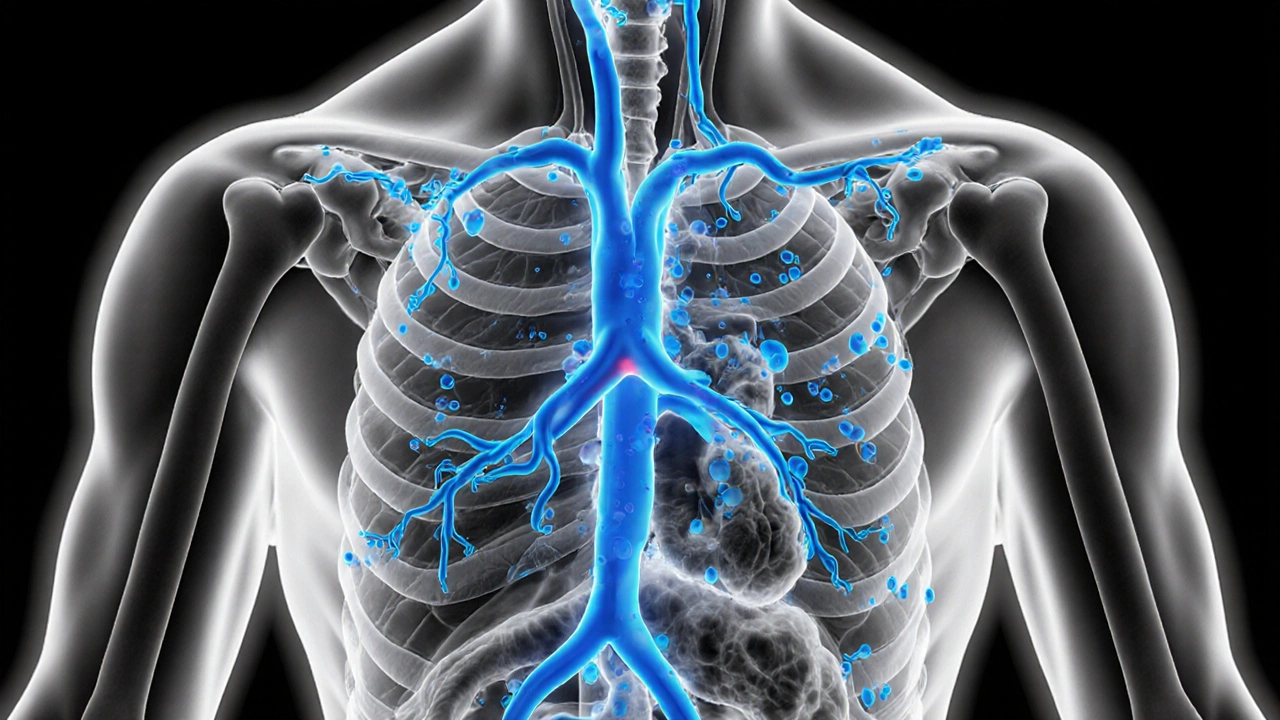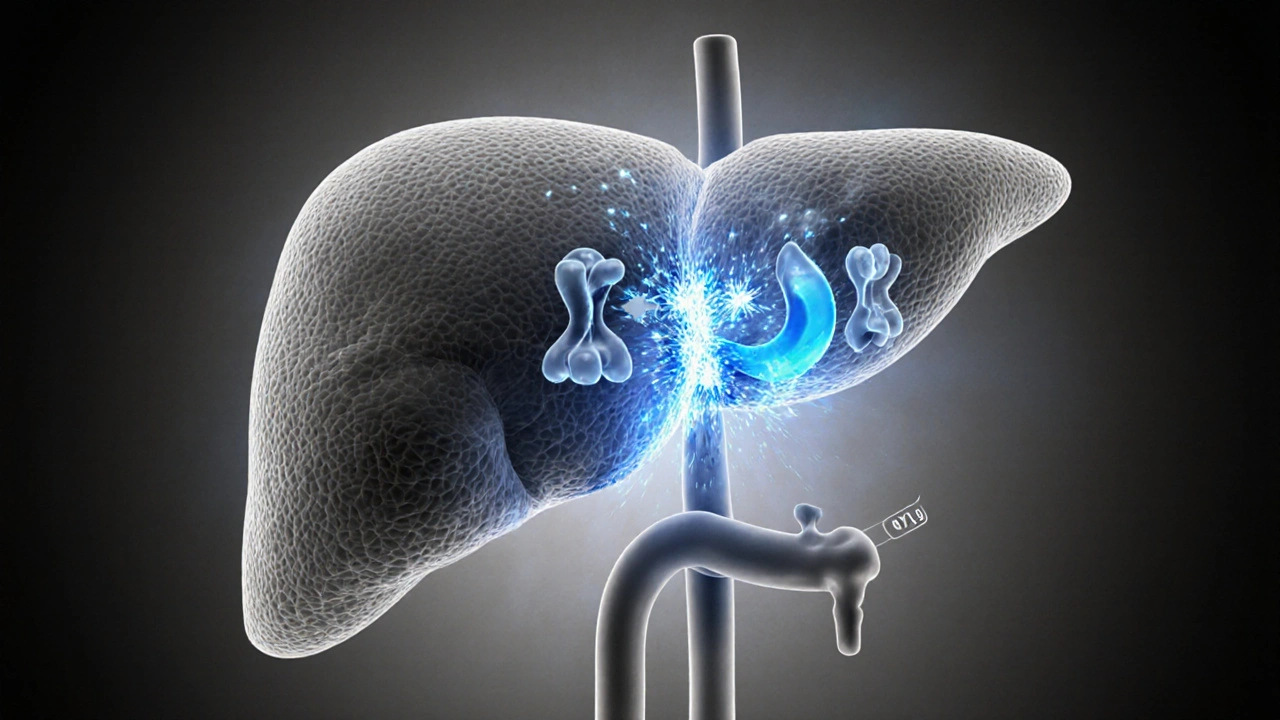Cyclophosphamide Dose Adjuster
Dose Adjustment Calculator
Adjust cyclophosphamide dose based on kidney function. The article explains that dose reductions of 25-30% are recommended when creatinine clearance falls below 30 mL/min.
Adjusted Dose:
Important: This tool provides general guidance based on the article content. Dose adjustments should always be made by a healthcare professional based on individual patient factors, lab values, and clinical judgment. Do not use this tool to adjust your own medication.
When you hear the name Cyclophosphamide is a chemotherapy alkylating agent that’s been used for decades to treat cancers and autoimmune diseases, you might wonder what actually happens once the drug meets your bloodstream. The short answer: it’s a pro‑drug that needs a series of liver enzymes to turn into the forms that kill cancer cells, and then your kidneys work hard to clear the leftovers. Let’s walk through each step, point out the numbers that matter, and see how clinicians tweak dosing to stay safe.
Why Cyclophosphamide Is Called a Pro‑drug
Unlike a ready‑to‑go bullet, cyclophosphamide arrives in your body as an inactive molecule. It relies on the liver’s cytochrome P450 system-especially the enzymes CYP2B6 and CYP3A4-to add an oxygen atom and split the structure open. This biotransformation creates two key players:
- Phosphoramide mustard, the DNA‑crosslinking agent that actually destroys tumor cells.
- Acrolein, a toxic by‑product that can irritate the bladder and cause hemorrhagic cystitis if not neutralized.
The fact that cyclophosphamide needs activation explains why liver function, drug interactions, and genetic variations in CYP enzymes can dramatically shift how much active drug you get.
Absorption and Distribution: Getting Into the Bloodstream
Whether you take cyclophosphamide by mouth or via IV, it’s almost completely absorbed-bioavailability hovers around 90‑100% for oral doses. After absorption, the drug distributes widely because it’s moderately lipophilic. It binds to plasma proteins at about 20‑30% and penetrates tissues, reaching the bone marrow, lymph nodes, and even the brain (though concentrations are lower there).
Key numbers to keep in mind:
- Volume of distribution (Vd) ≈ 0.6L/kg for adults.
- Peak plasma concentrations occur 1‑2hours after an oral dose and within minutes for IV.
Metabolic Activation: The Liver’s Role
The liver’s P450 enzymes convert cyclophosphamide into 4‑hydroxy‑cyclophosphamide, which then spontaneously forms phosphoramide mustard and acrolein. CYP2B6 handles roughly 50‑60% of the conversion, while CYP3A4 picks up the rest. This step is fast-half‑life for the initial metabolite is under 30minutes-so the active species appear quickly in the bloodstream.
Because the same enzymes process many other drugs (e.g., efavirenz, carbamazepine), co‑administered medications can either boost or blunt cyclophosphamide activation. A strong CYP3A4 inducer like rifampin can increase the formation of phosphoramide mustard, raising both efficacy and toxicity risk.

Elimination: How the Body Gets Rid of It
After the drug has done its job, the body works to eliminate both the active metabolites and the inactive parent. Renal excretion is the main pathway-about 70‑80% of an administered dose is recovered in urine within 48hours, mostly as inactive metabolites. The kidneys filter the compounds, and tubular secretion helps push them out.
Acrolein, the bladder irritant, can be trapped by the protective agent mesna. Mesna delivers a sulfhydryl group that binds acrolein, forming a harmless compound that’s excreted safely. Without mesna, up to 30% of patients develop some degree of cystitis.
Half‑life and Dosing: Balancing Effectiveness and Safety
The terminal elimination half‑life of cyclophosphamide varies with dose and patient factors, ranging from 3 to 12hours. In pediatric oncology, a typical half‑life is around 5hours, while in older adults with reduced renal function it can stretch beyond 10hours.
Because the drug’s activity depends on both the parent and metabolites, clinicians use weight‑based or surface‑area dosing and adjust for renal function. A common rule: reduce the dose by 25‑30% if creatinine clearance falls below 30mL/min.
Therapeutic regimens differ:
- High‑dose protocols for lymphoma may give 1g/m² IV over a few days.
- Low‑dose oral schedules for autoimmune diseases hover around 50-100mg daily.
Understanding the half‑life helps schedule cycles-most protocols repeat every 3‑4weeks to let blood counts recover.
Key Factors That Shift Pharmacokinetics
Several patient‑specific variables can swing the numbers:
- Liver function: Elevated AST/ALT or cirrhosis dampens CYP activity, lowering active metabolite formation.
- Renal function: Poor clearance raises exposure to inactive metabolites, increasing bladder toxicity risk.
- Genetics: Polymorphisms in CYP2B6 (e.g., *6 allele) can cut activation by up to 40%.
- Drug interactions: Strong CYP3A4 inhibitors (ketoconazole) can lower phosphoramide mustard levels, potentially reducing efficacy.
- Age and body composition: Elderly patients often have reduced Vd and slower clearance.
Clinicians may order therapeutic drug monitoring (TDM) for high‑dose regimens, measuring plasma phosphoramide mustard to fine‑tune dosing.

Comparison with Ifosfamide: A Similar Pro‑drug
| Parameter | Cyclophosphamide | Ifosfamide |
|---|---|---|
| Activation Enzyme | CYP2B6 / CYP3A4 | CYP3A4 / CYP2C9 |
| Key Active Metabolite | Phosphoramide mustard | Isophosphoramide mustard |
| Half‑life (terminal) | 3-12h | 6-10h |
| Renal Excretion | 70-80% as inactive metabolites | 50-60% as inactive metabolites |
| Neurotoxicity Risk | Low | Higher (encephalopathy) |
Both drugs share the pro‑drug concept, but ifosfamide carries a higher neurotoxicity profile and relies more on CYP3A4. That difference matters when patients are already on CYP3A4 inhibitors or have baseline neuropathy.
Practical Tips for Patients and Providers
Here are a few concrete actions that can make the pharmacokinetic dance work in your favor:
- Hydration: Drink plenty of fluids (at least 2‑3L/day) to flush metabolites and reduce bladder irritation.
- Mesna: If you’re getting high‑dose cyclophosphamide, follow the prescribed mesna schedule (usually 3‑times daily). Skipping it dramatically raises cystitis risk.
- Lab checks: Baseline liver panels and creatinine clearance guide the initial dose. Repeat labs before each cycle.
- Medication review: Tell your oncologist about over‑the‑counter drugs, especially antibiotics like erythromycin or antifungals like fluconazole, which can inhibit CYP activity.
- Genetic testing: If you have a family history of atypical drug reactions, ask about CYP2B6 genotyping.
These steps help keep the balance between killing cancer cells and sparing healthy tissue.
Frequently Asked Questions
How long does cyclophosphamide stay in the body?
The drug’s terminal half‑life ranges from 3 to 12hours, so it usually clears within 48hours after a single dose. However, metabolites can linger longer, especially in patients with reduced kidney function.
Why is mesna given with cyclophosphamide?
Mesna binds the toxic by‑product acrolein, forming a harmless complex that the kidneys excrete. Without mesna, up to one‑third of patients develop hemorrhagic cystitis.
Can liver disease affect how cyclophosphamide works?
Yes. Impaired liver function reduces the activity of CYP2B6 and CYP3A4, which slows the conversion to phosphoramide mustard. This can lower efficacy and may require dose adjustments.
Is it safe to take cyclophosphamide if I’m on other medicines?
Drug interactions are common because many medications share the same CYP enzymes. Always share your full medication list with the prescribing doctor; they may need to pause or change the other drug.
What monitoring is needed during treatment?
Baseline and periodic blood counts, liver enzymes, and kidney function tests are standard. For high‑dose regimens, plasma phosphoramide mustard levels may be measured to fine‑tune dosing.
Understanding the journey of cyclophosphamide inside your body demystifies why certain precautions exist. By keeping an eye on liver and kidney health, staying hydrated, and coordinating meds, you give the drug the best chance to do its job while minimizing side effects. If you’re starting therapy, ask your oncologist how these pharmacokinetic principles shape your personalized plan.

Nicola Gilmour
October 15, 2025 AT 12:23Staying well‑hydrated during cyclophosphamide therapy is absolutely key, especially because the kidneys need to clear the inactive metabolites quickly. I always remind patients to aim for at least 2‑3 liters of fluid a day, split across the dosing interval. Pair that with regular urine output checks, and you’ll catch any early signs of bladder irritation before they become a problem. Also, don’t forget to schedule your mesna doses right after the chemo – it’s the best safeguard against acrolein‑induced cystitis.
Keeping an eye on liver enzymes is another smart move; any elevation could mean slower activation and reduced efficacy.
Darci Gonzalez
October 23, 2025 AT 14:53Hydration is so important for flushing out those metabolites :) make sure you sip water throughout the day and don’t wait until you’re thirsty 😂 also, keep that mesna schedule on lock it’s a lifesaver for the bladder
Marcus Edström
October 31, 2025 AT 16:23One practical point worth noting is the impact of CYP2B6 polymorphisms on drug activation. Patients with the *6 allele often exhibit a 30‑40 % reduction in phosphoramide mustard formation, which can translate to sub‑therapeutic exposure. Genotyping before starting high‑dose protocols can therefore guide dose adjustments and avoid unexpected treatment failure. It’s also a good reason to review any concurrent meds that might inhibit CYP2B6, such as certain SSRIs.
kevin muhekyi
November 8, 2025 AT 18:53I’ve seen a few cases where patients were on fluconazole and their cyclophosphamide levels dropped unexpectedly. The enzyme inhibition really matters, so a quick med review before each cycle can prevent those silent under‑doses.
Teknolgy .com
November 16, 2025 AT 21:23Cyclophosphamide is basically a pro‑drug, nothing magical. 😒
Caroline Johnson
November 24, 2025 AT 23:53Honestly, this article glosses over the serious risks!!! The discussion of acrolein toxicity is woefully brief!!! Patients need a clear protocol for mesna dosing, and that is barely mentioned!!! Also, the impact of renal insufficiency on metabolite clearance is underestimated!!! We can’t afford half‑hearted advice when lives are on the line!!!
Megan Lallier-Barron
December 3, 2025 AT 02:23Well, maybe the author wanted to keep it light, but downplaying the renal issues feels reckless. Not every patient will have flawless kidney function, so a more detailed warning would be responsible.
Kelly Larivee
December 11, 2025 AT 04:53Drink plenty of water and keep track of your urine color – clear to light yellow means you’re flushing well.
Emma Rauschkolb
December 19, 2025 AT 07:23From a pharmacokinetic standpoint, maintaining eu‑volemia supports glomerular filtration rate, facilitating the excretion of both inactive metabolites and the acrolein‑mesna conjugate. 🧐 Consistent hydration also mitigates the risk of hemorrhagic cystitis, which is a major dose‑limiting toxicity in high‑intensity regimens.